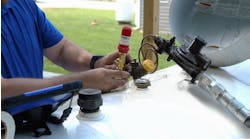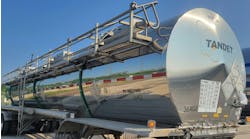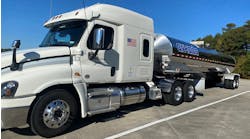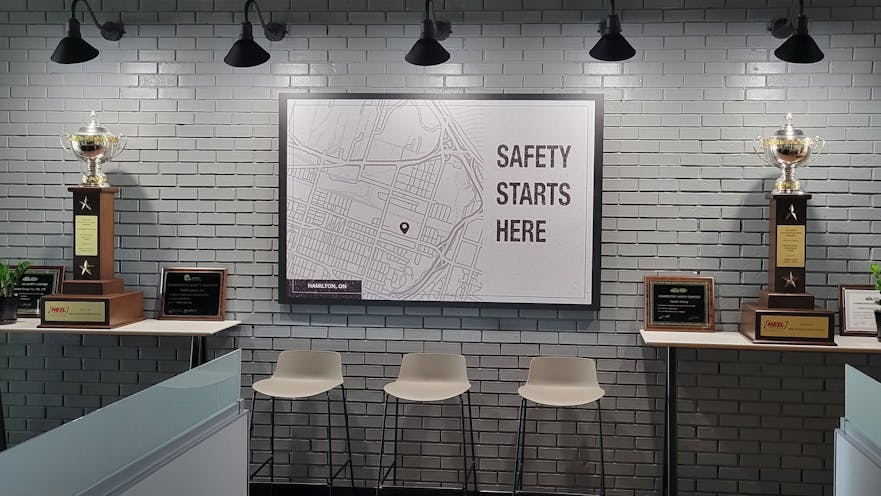After seeing Groendyke Transport win an unprecedented eighth Outstanding Performance Trophy the same year Tandet Logistics claimed its first, Tandet President Scott Tilley decided he wanted his operation to set a record, too. So he set his sights on becoming the first company to secure National Tank Truck Carriers’ North American safety championship in both for-hire categories.
The Canadian carrier hit that towering tank truck target only four years later.
Tandet attained its 2018 Heil Trophy in the Sutherland division, reserved for carriers who traveled less than 15 million miles, and the Oakville, Ontario-based bulk carrier group this year emerged with a 2022 trophy in the Harvison division for operators who traveled more than 15 million miles. Tilley credited several acquisitions that expanded Tandet’s fleet and propelled it into new markets, like hot products; and praised his team for keeping safety top of mind amid rapid growth.
Tandet claimed its first NTTC championship with an accident frequency of .150 per million miles—and repeated with lower .053 accident frequency for 2022.
In addition to claiming the Grand Award in the new Class 5 mileage category, Tandet—a member of the 7-million-mile club in 2018—earned the Grand Award in Class 5 in the Personnel Safety Contest with an incident frequency of 0.00 and was recognized for safety improvement over the previous year.
Finally, Dave Herdman, a veteran safety manager at Tandet, was named NTTC Safety Professional of the Year in the Harvison division. As Tilley indicated, “Dave helped design our safety system when we started as a tank truck carrier 30-plus years ago. Others have enhanced our safety programs as we have brought on new service lines, but Dave was the guy who helped set our standards. His drive to extend that philosophy for Tandet to be the best in a bigger operation has helped tremendously.
“He was instrumental in setting the tone for safety success in our larger business model.”
Stanley Cup
In his acceptance comments during the NTTC annual conference in Boston, Massachusetts, Tilley referred to Tandet’s win as the first Canadian sweep after another Northern fleet won in the Sutherland division.
“As a tank truck carrier based in Canada, my counterpart from Harmac was correct—this is our Stanley Cup, and it has been a long time since a Canadian hockey team has won that trophy,” he said. “I’m proud that this industry is recognized as the safest transportation segment, which is only right, as we deliver some of the highest-risk commodities. That’s a testament to what we do, north and south of the border. By learning from each other, tank truck carriers based in Canada or the U.S. drive some of the safest fleets across North America. NTTC, which promotes this award and keeps us focused on safety—not just by the contest, but the motto they live by, which ascribes the safety factor to everything we do—is also key.”
Tilley added that participation in NTTC and the safety competition has elevated the Tandet Group. “The same year we won our Outstanding Performance Trophy in the Sutherland division, Groendyke won its eighth trophy,” he said. “I had a chance to speak at length with Greg Hodgen, president of Groendyke. He described the success he was having with a flashing stop light mounted on the rear head of tank trailers.”
Based on Hodgen’s view that the light was reducing rear collisions, Tilley decided he wanted the system on his trailers. “I immediately changed the spec for some new tank trailers we had on order at the time, and we are now putting the system on all new trailers,” he said. “We believe it is a fundamental piece of safety equipment. I would never have known about this if we weren’t a member of NTTC.”
Tandet DNA
Tilley stressed safety is as much a part of the larger trucking company’s DNA as it was when the smaller management team brought home the first safety title.
“Every day, we are looking for new ways to improve the safety of our operation,” he said. “We realize, however, that safety improvement comes incrementally. We don’t have to make significant leaps forward for a successful program. We have a bit-by-bit improvement process across our entire operation. We want to get a bit better each day, each month.
“Along with the hard work, we also believe luck plays a role in the process. Sometimes when building a winning safety program, it’s good to have luck on your side.”
To keep the safety program on track toward the bit-by-bit improvement philosophy, the company increased the number of safety coaches on its teams to eight, bringing the drivers per safety coach to just over 30. The safety team is a subset of Tandet’s risk management team. Formed in 2022, when Mark Napier moved from general manager to safety director, the team meets every week and includes Steve Schroeder, compliance director; Lisa Little, compliance specialist; Ryan Tilley, vice president of transport operations; and Dave Miller, VP of people. As president, Tilley sits on the team to drive home the point that safety starts at the top.
“All of our corporate teams work together to ensure that a consistent message is communicated across our corporate system,” Tilley said. “This is how we have spread our safety culture across our company—on the road, in the yard, in the shop and the office. We know this strategy works because we did not suffer any decline in safety commitment or performance when we launched a major campaign to reorganize our company to focus solely on tank truck operations.”
Strategic reorganization
The reorganization began in 2018 with the divestiture of the majority of the company’s flatbed and van businesses. By 2020, Tandet was entirely focused on the shift to tank fleet operations, with the separate business units—including Connell Transport International and Tandet Dedicated—joining the group with a focus on tank services.
Several strategic acquisitions were completed to expand Tandet’s tank profile. These included Denali Transport, a sugar hauler now operating with 30 tankers in the Ontario and Quebec provinces, as well as four U.S. states. Flour hauler Crosscroft Transport was added in 2020, and then expanded to include flour and aggregate service into and out of the United States, and it now consists of 30 tractors and 50 tank trailers that are integrated with the sugar operations.
With the reorganization and the acquisitions, tank truck activity now accounts for 95% of Tandet’s trucking business. The cargo mix now includes a wide range of liquid and dry bulk products ranging from chlorine, specialty acids and other chemicals, plastics, asphalt, flour, and sugar.
“Customers have high service expectations, and they want carriers that pay attention to the details when handling the various cargoes,” Tilley said. “We want to operate in that environment where that is the expectation. These factors are valued more in the tank truck sector than in other operations.”
Today, Tandet runs 300 power units and 550 tank trailers, with operations conducted out of 10 terminals in Canada. A team of more than 300 drivers keeps the fleet moving. The company also employs a growing cadre of dispatchers and more than 30 mechanics/technicians at six shop locations.
Close to half of all loads go from Canadian manufacturers to U.S. customers, or from U.S. customers to Canadian plants. The carrier spends over 60% of its total miles operated in the U.S. while offering coverage to and from all continental states, including Alaska. Most Canadian-bound U.S. loads come from the Gulf Coast, Northeast, and Midwest.
“Canada and the United States offer mirror images from an economic perspective, and we are staying busy,” Tilley said. “2022 was probably the busiest and highest-paced year in our company’s history. We grew our customer profile and the areas we serviced through localized partnerships moving other carrier freight from the U.S. to Canada. It certainly created safety challenges, but our drivers and management team met them without missing a beat.”
Over the past five years, Tandet shifted from company drivers to owner-operators. Sixty percent of Tandet’s drivers now are owner-operators.
“This is partly by design and out of necessity,” Tilley said. “It’s easier to attract owner-operators today. Canada’s system is different from the United States in that owner-operators run under fleet authority in Canada. Our owner-operators are more willing to be out three to seven days at a stretch. But some only work locally or regionally.”
Creating drivers
Tandet is every bit as selective with owner-operators as it is with company drivers. The training regimen is strict and requires drivers to learn the Tandet way to operate safely, and interact with customers, their customers, and the public.
“Even though Canada faces the same truck driver shortage as the United States, we will not back off on our basic driver requirements and performance expectations,” Tilley said. “We look for drivers with at least three years of over-the-road truck driving experience in Canada. We prefer candidates with at least some tank experience. But we are more than willing to make a good driver into a professional tank truck operator.
“We make professional tank truck operators in this company,” he added. “It takes about 10 months to get an experienced, motivated truck driver to that level. Transitioning a driver with van fleet experience to tanks takes six to eight weeks. For those with tank experience, the initial orientation process takes three to four weeks. This is followed by many months of coaching and mentoring, using safety coaches and senior driver mentors.
Even with the broader pool of truck drivers available through the owner-operator community, Tandet is still looking for more sources of drivers. In selective instances, the company has recruited recent graduates from truck driving schools.
“If they can drive a truck, we can teach them to be tank truck operators,” Tilley said. “We start them with non-hazardous cargoes such as flour, sugar, or plastics.”
Ukrainian driver
The carrier has even launched a long-term project with a recent immigrant from Ukraine. “He emigrated at the start of the war and moved in with one of our general managers and his spouse. Luckily, he always wanted to be a truck driver, even though he was a drywall installer. He started with us in our logistics operation while he learned English as a second language,” Tilley said. “He learned English and how to drive a car on Canadian roads, went through truck driving school and is now assigned to our logistics team, working with one of our mentors, while gaining experience hauling plastics in Canada on quad-axle tanks.”
Like other new drivers joining the Tandet operation, the Ukrainian trainee has been in training with a mix of classroom instruction, online videos, and mentoring by senior drivers.
One reason for the intense training for new drivers is the sheer challenge of hauling many hazardous and non-hazardous cargoes across such a large and diverse geographic area. With operations spanning Canada and the U.S., it’s critical that all drivers are updated on the latest trucking and hazmat regulations.
Fleet spec
Can’t forget about the equipment. Provincial and federal regulations in Canada allow more generous gross combination weights than are legal in most U.S. states—up to 160,000 lbs. vs. the 80,000 lbs. allowed on the U.S. interstate highway system. Tractors and trailers must be properly matched, and drivers must know that the correct trailers have been selected for U.S.-bound shipments.
“Our operation requires very targeted use of equipment,” Tilley said. “It’s not a simple process. The safety routine is very much a part of the system. A unit with 160,000 lbs. reacts very differently than one at 80,000 lbs. That is simple dynamics, but when a ‘live’ load is factored in, it changes how one drives.
“For instance, a tractor configured for U.S. operations can’t pair with one of our five-axle Canadian tank trailers. So we run B-trains in our intra-Canadian operations and have tandem-axle trailers for our U.S. operations.”
Tandet runs stainless-steel tank trailers from Tremcar and Polar with capacities ranging from 6,000 to 12,000 gallons, Etnyre and Polar asphalt trailers, and dry bulk trailers from Tremcar, Bedard, Heil, and J&L Tank with capacities ranging from 1,625 cu. ft. to 2,800 cu. ft.
Tractor supply
In its company-owned fleet, Tandet runs both U.S.- and Canada-spec’d tractors. “It’s still a struggle to get enough equipment to keep up with our internal growth,” Tilley said. “Our most recent purchases have been predominantly Freightliner Cascadias, but we also have Kenworths on order as we can’t get enough Freightliners. All units are built to order as we are demanding on the trucks that we supply to our drivers. Over the past three years, we’ve received about a third of the tractors we ordered. So we are a bit behind on the replacement cycle, which has limited our desired company truck fleet growth.”
Safety equipment on the tractors includes collision avoidance, forward-looking onboard cameras, tire pressure monitoring, and automated chassis lube systems. Testing is underway on side-mounted cameras. For electronic logs, the carrier uses the Isaac Instruments system, which includes a cellular-based tablet computer that provides GPS tracking and can seamlessly handle the transition between Canadian and U.S. driver logs and vehicle inspection reports.
A scoring system that compares drivers’ tendencies and characteristics is built into the Isaac technology. Factors include hard braking and sharp cornering. Each driver receives a score based on 100. And the best drivers (those who hit 95 or better) get the best fuel mileage—whether they are pulling tandems, quads, five-axles, or B-trains—an added benefit beyond better safety performance.
“We’re seeing safety benefits with the system,” Tilley said. “We’ve reduced fuel consumption and have a safer fleet because of it. Our drivers also benefit from an annual bonus of up to $6,000 for meeting a specific Isaac score and incident- and accident-free driving. About 10% of our drivers currently qualify for the full bonus.
“We’re constantly refining the on-board system. We are currently exploring using artificial intelligence to identify changes in driver attitude and performance more accurately. It’s all part of our effort to continually improve our winning safety program.”
And, to ensure they continue to get just a little bit better every year, the company now is developing an exclusive Tandet Safety Learning Series using videos delivered through in-cab devices, so drivers can watch in their idle hours, complimenting another general video system they’ve used for over four years now.
“The two things that work best for our ongoing performance are our safety DNA and the belief we can always get a bit better in all that we do, including customer service, equipment specifications, employee/contractor relations, supplier support, and most importantly, safety.” Tilley concluded.
“It’s just what we do.”









